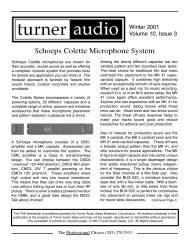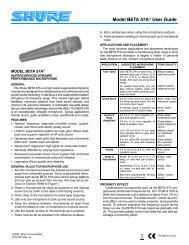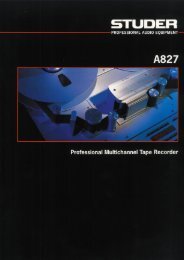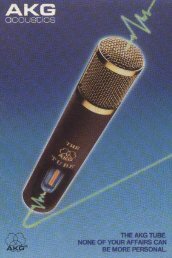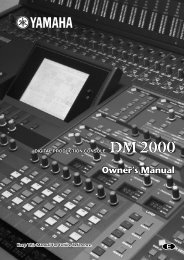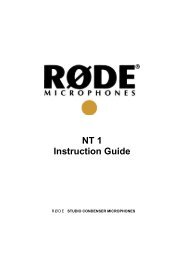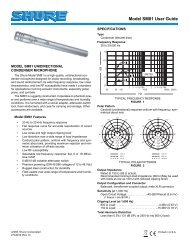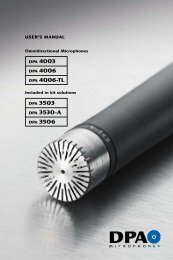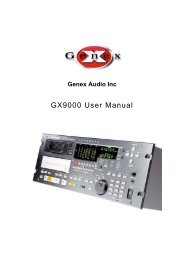M-1 Mic Preamp M-2 Mic Preamp M-1 Personal Mic ... - John Hardy
M-1 Mic Preamp M-2 Mic Preamp M-1 Personal Mic ... - John Hardy
M-1 Mic Preamp M-2 Mic Preamp M-1 Personal Mic ... - John Hardy
You also want an ePaper? Increase the reach of your titles
YUMPU automatically turns print PDFs into web optimized ePapers that Google loves.
1728 Brummel St.Evanston, IL 60202USAIllustratiTHE JOHN HARDY COMPANYPhone: 847-864-8060Toll-free: 866-379-1450Fax: 847-864-8076www.johnhardyco.comM-1 <strong>Mic</strong> <strong>Preamp</strong>June 1, 2011M-2 <strong>Mic</strong> <strong>Preamp</strong>M-1 <strong>Personal</strong> <strong>Mic</strong> <strong>Preamp</strong>The M-1, M-2 and M-1 <strong>Personal</strong> mic preamps are among the finest mic preamps in the world. They providethe accuracy and transparency that is missing in other mic preamps. No matter what your application, theywill provide superior results. The world's best input transformer (Jensen JT-16-B), best op-amp (990Cdiscrete class-A op-amp) and the elimination of all coupling capacitors from the signal path combine toprovide the highest performance.The M-1 and M-2 have a 19” wide rack-mount chassis (1.75”H x 19”W x 8”D) and can be ordered with one, two, three or fourchannels. The M-1 <strong>Personal</strong> mic preamp has an 8” wide chassis with a capacity of one channel. There are two meter options,and the best Jensen output transformer (JT-11-BMQ) is available as an option. These options and basic channels can be easilyadded later.The M-1 was introduced in 1987. The M-2, introduced in 1996, is a variation of the M-1. The first difference is the gaincontrols: The M-1 has a two-section gain-pot providing continuously variable adjustment in two overlapping ranges of 12 to 40dB and 32 to 60 dB (higher gain available on request). The “HIGH GAIN” switch changes ranges. The M-2 has a 16-positiongain-switch with 1% metal-film resistors, providing accurate and repeatable gain-settings from 15 to 60 dB in steps of 3 dB.Further differences involve the push-button switch to the right of the gain-pot or gain-switch. The M-1 has a “HIGH GAIN”switch as mentioned above. Since this switch is not required in the M-2, the p.c. board layout was modified to allow that switchto be used in the M-2 as either a “20Ω MIC” switch, or a “20dB PAD” switch, depending on how the board is assembled. The20Ω MIC switch provides optimum matching of microphones with extremely low output impedances. The 20dB PAD switchattenuates the input signal by 20 dB prior to the JT-16-B input transformer, providing a maximum input level of +29 dBu.1
The Jensen JT-16-B Input Transformer isJensen's best mic-input model. Jensen isknown worldwide for their superior audiotransformers. If you thought transformerswere a compromise, you haven't heard theJT-16-B!The JT-16-B is a large, low impedanceratio (150:600Ω) transformer made with aproprietary 80% nickel (nickel-iron-molybdenum)core material. The large sizeallows it to handle extremely high signallevels of +12dBu at 30Hz and above,+9.7dBu at 20Hz. The low ratio providesless distortion, flatter frequency responseand more linear phase response than moretypical high-ratio transformers(150:15kΩ). The proprietary 80% nickelcore material is far superior to, and muchmore expensive than the steel often foundin other transformers.The JT-16-B outperforms transformerlessmic preamps because it eliminates theinput coupling capacitors that are usuallyrequired with transformerless designs.Capacitors degrade the audio signalbecause they have a property known asdielectric absorption. Some of the signalpassing through the capacitor is absorbedM-1: Dual Range Gain Control and “HIGHGAIN” Switch. The overall gain adjustmentrange is 12 to 60 dB, a span of 48 dB.Rather than cover the entire 48 dB in onerevolution of the gain pot, there are twosmaller, overlapping ranges selected by the“HIGH GAIN” switch. The low gainrange provides adjustment of 12 to 40 dB,the high gain range 32 to 60 dB (highergain can be provided on request). Thisprovides 28 dB of adjustment per range,with 8 dB of overlap. The relatively small28 dB of adjustment per range providesgreat feel and resolution, with sufficientoverlap to keep you “in range” at all times.There are two reasons for the great feel:First, with fewer dB of adjustment perrevolution, it is easier to adjust the pot tothe desired gain setting. The second reasonis a more technical one, and veryimportant. A single 10kΩ pot covering theentire 48 dB range in a single revolutioncould get a bit “touchy” as it approachesthe maximum gain point (minimumresistance), due to contact resistancevariation (CRV). The gain pot of the M-1is actually a two section pot having a 10kΩsection and a 500Ω section. In high gainHighlightsby the dielectric of the capacitor, thenreleased a short time later. This smearsthe signal. Transformerless designsrequire these capacitors to keep thephantom supply voltage from reachingthe circuitry of the preamp. Transformersinherently block DC voltages,eliminating the need for the capacitors.The JT-16-B provides better commonmode rejection than transformerlessdesigns, important in electrically noisyenvironments. It handles common modevoltages as high as ±300V peak.Transformerless designs are usuallylimited to maximum voltages equal totheir power supply voltages, typically±15V to ±18V.The 990C Discrete Op-Amp is faster,quieter, more powerful and bettersounding than the typical monolithic opampsfound in other equipment. Eachindividual (discrete) transistor, resistor,diode, capacitor and inductor of the990C has been carefully chosen for itstask. This provides a level ofperformance that is not possible in amonolithic op-amp where all componentsare fabricated on the same tiny chip ofStandard Featuresapplications where CRV would be aproblem with a 10kΩ pot, the 500Ωsection of the pot is used. CRV isreduced by a factor of twenty, virtuallyeliminating any touchiness. See page 5for details.The unusually low minimum gain of 12dB allows the M-1 to handle input levelsas high as +12 dBu before the output isdriven past its +24 dBu maximum outputlevel. The JT-16-B input transformer canhandle input levels of +12 dBu at 30 Hzand above, and +8 dBu at 20 Hz.If you need infinite resolution so you canset the mic preamp to any gain, or beable to “ride gain” during a performance,the gain controls of the M-1 are ideal.M-2: 16-Position Rotary Gain-Switch with1% metal-film resistors provides accurateand resettable gain control from 15 to 60dB in steps of 3 dB (higher gain can beprovided on request). For situationswhere exact gain-matching of channelsor exact resettability is required, the gaincontrols of the M-2 are ideal.2silicon. The 990C operates from ±24Vpower supplies, allowing output levels ofgreater than +24dBu. It can drive longcables and loads as low as 75Ω, somethingmonolithic op-amps cannot do. See the 990data package for further information.Elimination of All Coupling Capacitors fromthe Signal Path results in less degradationof the audio signal. Two superiortechniques are used to accomplish this:1. Input bias current compensationcircuitry nulls out the small DC currents(thus voltages) that flow from the inputs ofthe 990C (or any op-amp), voltages thatcould cause noise when operating the gaincontrols. This circuitry also reduces theDC offset voltage at the output of the990C. Most other mic preamps usecoupling capacitors to block the input biascurrents, resulting in signal degradation.2. DC servo circuitry nulls out the DCoffset voltage at the output of the 990C,eliminating the need for a traditionaloutput coupling capacitor to block thatvoltage. The signal degradation caused bythat capacitor is also eliminated. See theschematic on page 7 for details.M-2: “20Ω MIC” Switch provides optimummatching with microphones that have a20Ω output impedance. Note that theJensen JT-16-B mic-input transformerdoes exceptionally well with just aboutany low-impedance microphone, includingthose with a 20Ω output impedance, butthis switch provides further refinement.The switch takes the place of the “HIGHGAIN” switch of the M-1.M-2: “20dB PAD” Switch provides a 20dBresistive pad before the input transformer.This increases the maximum input level to+29 dBu for situations where excessivelyhigh input levels are encountered. Mostapplications won't need a pad, but forthose that do, this option provides it. Thisswitch takes the place of the “HIGHGAIN” switch of the M-1.Note that you can get an M-2 channel builtwith the “20Ω MIC” option or the “20dBPAD” option, but not both. These optionstake advantage of the fact that the “HIGHGAIN” switch of the M-1 is not needed inthe M-2, and the p.c. board was modifiedto allow that switch to be used in one ofthree ways.
M-1 and M-2 Common Features:Polarity Reverse Switch (“POL REV”)reverses the signal polarity immediatelybefore the input transformer.48V ON/OFF Switch (“+48V”) for phantompower. The phantom supply has more thanenough current to handle any condensermicrophone.All Front Panel Switches are LEDIlluminated. A custom clear plastic pushbutton was developed for the M-1 and M-2. Each button's function is marked on thefront surface and is illuminated dimlywhen off, brightly when on, each buttonwith its own LED color. The HIGH GAINswitch of the M-1 (20Ω MIC or 20dBPAD for the M-2) uses a red LED, thePOL REV switch uses an amber LED andthe +48V switch uses a green LED. Noguessing about these switches!Gold Plated XLRs for maximum reliability.Gold does not tarnish or oxidize.Ground Lift Switch on Each Channel allowsVU-1 Meter Card is a very accurate andinformative meter that directly monitors theoutput level of the MPC-1 mic preamp card.There is no need to monitor the input levelof the MPC-1 because the output will clipbefore the input transformer saturates.The VU-1 provides a 20 segment LEDbargraph display and separate “peak” LED(labeled “PK” on the front panel) to indicateextremely high signal levels. An LED-illuminatedfront panel switch (green LED)gives a choice of “Peak” or “VU” meterballistics. The “Peak” ballistic provides afast attack time for the bargraph so thattransients are fully indicated. The “VU”ballistic provides a slower attack time,similar to a standard mechanical VU meter.The meter scale accurately covers -28 to+10dB in linear steps of 2dB (15 yellowLEDs, 5 red LEDs). Easy calibration of themeter's 0VU operating level is accomplishedby moving an internal plug-in jumper to oneof four positions: 0dBu, +4dBu, +8dBu orADJustable. The “ADJ” position covers arange of -10 to +12 dBu via a 25-turn trimpot. Standard setting is “+4” (0VU on themeter scale equals a +4 dBu output level).The firing point of the separate peak (PK)LED is calibrated via a 25-turn trim pot foroutput levels of 0 to +22dBu. The standardsetting of +22dBu provides at least 2dB ofwarning prior to clipping. Jumpers aredisconnection of the shield (pin 1) of theoutput XLR. This can be helpful ineliminating ground loops. This minitoggleswitch is on the rear panel.Toroidal Power Transformer withadditional silicon-iron shieldingeliminates hum problems caused by straymagnetic fields. Some manufacturers usea separate power supply chassis andumbilical cord to keep the powertransformer's stray magnetic fields frominterfering with the audio circuitry. Inthe M-1 and M-2, the stray magneticfields are controlled at the transformer.Each transformer is carefully tested forstray magnetic fields under worst-casefull-load conditions. The optimumrotational position is determined, thenthe silicon-iron shielding is added toassure hum-free performance. Thanks tothese extra details, the transformer canbe built into the M-1 or M-2 chassis. Noseparate chassis and umbilical cord todeal with.Toroidal power transformers inherentlyhave lower stray magnetic fields thanOptionsprovided to choose BAR mode(cumulative LEDs) or DOT mode (oneLED at a time) for the display.Circuitry includes a full-wave rectifier,peak detector, Peak and VU ballistics, anda temperature compensated log/linearconverter. The circuitry is DC coupled anduses high-speed, precision op-amps withextremely low DC offset voltage and drift(better op-amps than you find in the signalpath of many consoles!). All of thesefeatures guarantee accurate performanceover a wide temperature range, and foryears to come. On-card voltage regulationfor the op-amp power supplies, andisolated grounding for the 5 volt LEDpower supply assure that the VU-1 will notinterfere with the mic preamp circuitry.PK-1 Meter Card provides a peak LEDfunction only. It uses the same full-waverectifier, peak detector, 25-turn trim pot forsetting the firing point of the LED, on-cardvoltage regulation and isolated groundingfor the 5 volt LED power supply that isused on the VU-1 card.JT-11-BMQ Output Transformer is the bestJensen line-output transformer. Itcompliments the outstanding line drivingcapability of the 990C by providing abalanced, floating, isolated output. Groundloop problems are eliminated because the3conventional EI-core transformers. Theyare also smaller and lighter. They are alsomuch more expensive!Universal Power Supply. An internal switchprovides six primary voltage choices: 100,120, 140, 200, 220 and 240 volts. Thepower cord is detachable, with a line filterincluded in the input connector. Thesefeatures allow the preamps to be easilyadapted for use anywhere in the world.The supply accommodates over/undervoltage situations easily.Chassis Ground Isolation Switch allows thechassis ground to be isolated from thesignal ground, or tied to it. This can behelpful in eliminating ground loops incertain situations. This mini-toggle switchis on the rear panel.Built to Order, the way YOU want it. Startwith only one basic channel if you wish.Additional channels, meters and outputtransformers can be easily field-installed.The mainframe is ready for all fourchannels, with blank panels provided forunused channels. Have it your way!signal is coupled magnetically rather thandirectly, something that transformerlesscircuits cannot do. Your application may notrequire an output transformer, but if youneed one, the JT-11-BMQ is the best.PIN 2 or PIN 3 HIGH? There are two polaritystandards in use today for XLR connectors.The official IEC, SMPTE and AESstandards state that pin 2 is high (relative topin 3), while the unofficial standard statesthat pin 3 is high (relative to pin 2). The M-1and M-2 make it very easy to deal with this.A pair of plug-in jumpers is located next toeach XLR, allowing you to quickly changefrom “PIN 2 HIGH” to “PIN 3 HIGH”, orvice-versa.It is very important to verify the polarity ofthe equipment that will be used with the micpreamp, and to maintain correct polaritywhen connecting the mic preamp. Possibleproblems range from an audible change dueto an inadvertent reversal of polarity, toslight degradation of the signal if atransformer-coupled output is driving anunbalanced input of the opposite polarity, topossible damage to the 990C in a directoutputconfiguration driving an unbalancedinput of the opposite polarity (driving ashort-circuit!). Please specify PIN 2 HIGHor PIN 3 HIGH!
A few Important DetailsFactory Selection of Critical Parts. R2 andR3, the 6.81kΩ resistors in the phantomsupply network, are matched to 0.1%tolerance for the best performance.1% 100ppm Metal Film Resistors are usedinstead of the more common 5% 200ppmcarbon film resistors. They provide greaterinitial accuracy, better long term stability,and higher stability at extremes oftemperature.Polycarbonate Capacitors are used incritical timing circuits instead of cheapermylar or polyester capacitors. They aremuch more stable, and have a more linearimpedance.Electrolytic Capacitors with a 105°CTemperature rating are used instead of themore common 85°C rated parts. Thishigher temperature capability means thatthey will last much longer than the lowerrated parts. They will also have better,more linear performance over a widertemperature range. Electrolytic capacitorsare more failure prone than most othercomponents (a good thing to rememberwhen troubleshooting older equipment).Sometimes they allow small amounts ofDC current to pass through (leakagecurrent), causing pots and switches to benoisy when operated. (NOTE: in the M-1and M-2 there are no capacitors in thesignal path, so this problem cannot exist).Other capacitors will short-circuit, or losemost of their capacitance. Whatever thefailure mode, you have a problem, even inequipment that never approaches anoperating temperature of 85°C. But notwith these mic preamps!XLR Connectors are Soldered Directly tothe P.C. Card, minimizing the number ofinterconnections for better reliability andbetter sound quality.Fully Sealed Potentiometer and Trim Potsfor long, trouble-free life.Central Point Grounding and PowerDistribution. Rather than use a“motherboard”, wiring harnesses areused to deliver power supplies andgrounds to each channel individually.This provides the least interactionbetween channels.The KNOB. A knob is a basic device thatshould provide three basic things:1. Good VISUAL indication of setting.2. Good TACTILE indication of setting.3. Good TRACTION for your fingers.Most knobs don't meet all three of therequirements. Some don't meet any of therequirements! In addition to these basicrequirements, a knob should look goodand feel good.Plastic knobs look like . . . well . . .plastic knobs! Plain round knobs don'tgive any tactile indication of which waythey are pointing. Knobs with pointers orbars sticking out do tell by feel whichway they point, but the protrusion isoften so big that it gets in the way. Someknobs have an indicator line on top, butthe typical decorative metal finish causeslight reflections from the top like spokes ofa wheel. Which is the indicator line andwhich are the spokes?This knob was developed to meet allrequirements. It is machined out of solidaluminum, with a nonreflective blackanodized finish. A laser-cut white ceramicinsert is added to create visual and tactileindication of the knob's setting. The insertappears as an indicator line on the top ofthe knob, and protrudes just enough(.025”) beyond the side of the knob so thatyou can feel it, yet it doesn't get in the way.Traction is provided by a fine diamondknurl with sharp, fully formed teeth. Thediamond knurl provides traction for rotarymotion, and for vertical motion to keepyour fingers from slipping “up” and off ofthe knob. Straight knurls can only providerotary traction. Also, there is a certainamount of tradition in a diamond knurl.The knob looks great, feels great, andworks great!An Extruded Aluminum Chassis wasdeveloped for the front, rear and sides ofthe M-1 and M-2 chassis. It solves anumber of packaging problems, providinga neater, stronger and more efficientpackage. The brushed and black anodizedfinish looks great, and provides optimumthermal emission properties. Rack-handlesare provided for easy installation andhandling. Stainless steel threaded insertsare used for long life and the ability towithstand repeated assembly &disassembly.Condensed Typical Specifications (0dBu = 0.775V)E.I.N., 20-20kHz unweighted, 150Ω source: -129 dBu0Ω source: -132 dBuMaximum input level, M-1 >30Hz: +12 dBuMaximum input level, M-2 >30Hz: +9 dBuMaximum input level, M-2 with pad >30Hz: +29 dBuMaximum output level at 990 output 75Ω load: +24 dBuCMRR 60Hz: 117 dB10kHz: 80 dBDeviation from linear phase 20Hz-20kHz: +1.1/-0 degTHD, JT-16-B, (below saturation) 20Hz 0.036 %30Hz: 0.022 %50Hz: 0.010 %1kHz: 0.003 %THD, JT-16-B & 990:60dB gain, 10kΩ load, +24dBu output 10kHz: 0.005 %1kHz: 0.004 %40dB gain, 600Ω load, +24dBu output 10kHz: 0.003 %1kHz: 0.003 %40dB gain, 75Ω load, +24dBu output 10kHz: 0.030 %1kHz: 0.005 %DC offset
Contact Resistance and Contact Resistance VariationThe most familiar specifications forpotentiometers are: resistance value,tolerance and taper. Even these simple specswill vary with temperature, time, appliedvoltage, number of rotations, etc., but theyare pretty straight forward. However, contactresistance (CR), and contact resistancevariation (CRV), are specifications that areunfamiliar to many people.A pot has a moving contact, or “wiper”, andit is positioned along the surface of aresistance element. The key tounderstanding the problems of CR and CRVis to realize that the resistance element has asmall but measurable thickness to it, and thecurrent flow is not always occurring exactlyat the surface of the element. This is becausethe current flow follows the path of leastresistance created by the imperfect blend ofconductive and non-conductive materialsused to make the element. There is ameasurable amount of distance, thereforeresistance, between the contact and thenearest point of current flow. This contactresistance (CR) can be as much as 2% of thepot's resistance value, and will vary as thecontact is moved from one position to thenext (CRV). If the current is flowing nearthe surface of the element at the contactposition, CR is low. If the current is flowingfar below the surface at the contact position,CR is high. For example, if the pot measuredexactly 10kΩ from end to end, and if youcould find the exact electrical midpoint ofthe resistive element, it could measure5200Ω from either end to the contact sittingat the midpoint. It takes 5000Ω to get tothe midpoint of the resistive element, andan additional 200Ω to get to the surface ofthe element where the contact is, assuminga worst-case CR of 200Ω.When a pot is used as a rheostat, as it is inthe gain control of the MPC-1 mic preampcard, the CR must be added to the basicelement resistance when making gaincalculations. The gain pot of the MPC-1card is configured so that a reduction ofresistance causes an increase of gain.For the following example let's assume asingle section 10kΩ pot is used, coveringthe entire 48dB adjustment range (12 to60dB) in a single revolution. Due to thelogarithmic nature of audio, it takes almosta 2kΩ reduction of resistance (10kΩ to8kΩ) to provide a 1 dB increase of gainwhen going from 12 to 13 dB of gain,while it takes a mere 10Ω reduction ofresistance (70 to 60Ω) to provide a 1 dBincrease when going from 47 to 48 dB ofgain. The worst-case CR of 200Ω (2% of a10kΩ pot) would be insignificant in thefirst instance (resistance change from10kΩ to 8kΩ for a gain change of 12 to 13dB), since a CR of 200Ω is smallcompared to the 2kΩ change in gain potresistance. But if you were increasing thegain from 47 to 48 dB by changing thegain pot setting from 70 to 60Ω, a CR of200Ω could definitely be a problem,compared to the desired 10Ω change ingain pot resistance. Imagine a worst-casesituation: at the theoretical 70Ω position,contact resistance might happen to add 10Ω,while at the theoretical 60Ω position, contactresistance might happen to add 200Ω.Instead of going from 70Ω to 60Ω, youwould actually be going from 80Ω to 260Ω.The resistance goes up instead of down, andthe gain is decreased by more than 8 dBinstead of the 1dB increase you planned on!The next nudge of the control could havejust the opposite effect. It is highly unlikelythat CRV would be that bad, but it isunpredictable and undesirable.The gain pot of the MPC-1 mic preamp cardis actually a two section pot (RV1A andRV1B on the schematic on page 7), with a10kΩ section and a 500Ω section. In thelow-gain mode (12 to 40 dB), the HIGHGAIN switch shorts across the 500Ω sectionof the pot, leaving just the 10kΩ sectionactive. The CR of a 10kΩ pot is not aproblem at lower gains, as mentioned earlier.In the high-gain mode (32 to 60 dB), theHIGH GAIN switch shorts across the 10kΩsection, leaving just the 500Ω section active.Contact resistance would be a problem atthese higher gains if you were still using the10kΩ pot, but the worst-case CR is just 10Ωwith the 500Ω pot, compared to 200Ω withthe 10kΩ pot. This reduces the CRVproblem by a factor of twenty. The result is amuch smoother, more consistent and higherresolution gain control.5



